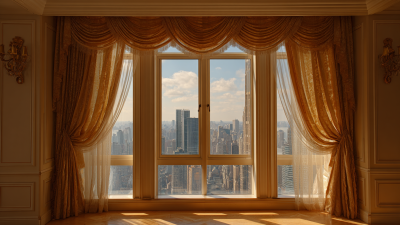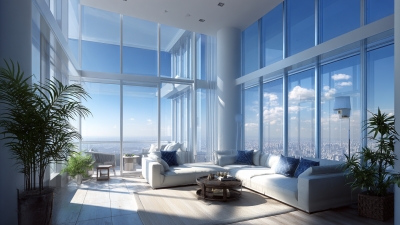The Comprehensive Handbook for Choosing the Perfect Residential Doors
The choice of residential doors is crucial not only for aesthetic appeal but also for enhancing security and energy efficiency in homes. According to industry reports, high-quality residential doors can reduce heat loss by up to 20%, which contributes significantly to lower energy bills—an essential consideration for homeowners aiming to maximize comfort while minimizing costs. Furthermore, a survey by the National Association of Home Builders found that over 80% of potential buyers consider the quality and style of doors as a vital factor in their purchasing decisions. This comprehensive handbook aims to guide homeowners through the myriad options available in the market, providing valuable tips and insights into selecting the perfect residential doors that align with individual preferences and functional requirements. By understanding the latest trends and standards, homeowners can make informed decisions that enhance both the beauty and integrity of their living spaces.

Table of Contents
[Hide]
Understanding the Different Types of Residential Doors: Pros and Cons
When selecting the ideal residential doors, understanding the various types and their associated pros and cons is crucial. According to the National Association of Home Builders (NAHB), entry doors account for 54% of the average homeowner’s renovation budget, underscoring their significance in home improvement projects. Traditional wooden doors are often celebrated for their aesthetic appeal and durability; however, they require regular maintenance to prevent warping and weathering. Industry reports indicate that the lifespan of a well-maintained wooden door can reach up to 30 years, but these doors may also be prone to rot and require periodic refinishing.

In contrast, fiberglass doors have soared in popularity due to their low maintenance and energy efficiency, with Energy Star-rated options providing up to 20% better insulation than traditional wooden doors. A study by Remodeling Magazine highlighted that while fiberglass doors typically come with a more substantial initial investment, their long-term savings on energy costs can be significant. Steel doors also offer robust security and durability, often providing enhanced protection against forced entry. However, they can be susceptible to dents and rust, particularly in humid climates. By weighing these factors, homeowners can make informed decisions that best fit their needs and enhance their property's value.
Key Materials for Residential Doors: Choosing Between Wood, Metal, and Fiberglass
When it comes to selecting residential doors, understanding the key materials is essential for both aesthetics and functionality. Wood, metal, and fiberglass are the three primary options, each with unique characteristics. Wood doors offer a timeless charm, bringing warmth and character to any home. They are highly customizable, available in various designs, grains, and finishes, allowing homeowners to match their door to the overall style of their residence. However, wood doors require regular maintenance to prevent warping and damage from moisture.
Metal doors, typically made from steel or aluminum, are celebrated for their durability and security. They are resistant to impacts and offer excellent insulation properties, making them ideal for energy efficiency. Additionally, metal doors can withstand various weather conditions without the need for extensive upkeep. However, they may lack the aesthetic appeal of wood and can be prone to dents and scratches if not treated properly.
Fiberglass doors provide an appealing middle ground, combining durability with the look of wood. They are energy-efficient, resistant to moisture, and require minimal maintenance. With advancements in manufacturing, fiberglass doors can mimic the appearance of wood grain while remaining impervious to peeling or fading. This makes them a popular choice for homeowners seeking a long-lasting, versatile option that doesn't compromise on style.

Essential Factors to Consider When Selecting the Right Doors for Your Home
When selecting the right residential doors for your home, several essential factors come into play that can impact both aesthetics and functionality. Firstly, the material is a critical consideration; options like fiberglass, wood, and steel offer different levels of durability and insulation. According to a 2022 market report, the fiberglass door market is projected to grow significantly due to its energy efficiency and low maintenance requirements. Choosing a door type that aligns with your climate can enhance comfort while reducing energy costs.
Another vital factor is security features. Homeowners increasingly prioritize safety, with studies indicating that over 60% of home burglaries happen through the front door. Investing in doors equipped with advanced locking systems and sturdy frames can deter potential intruders. Additionally, aesthetic appeal is important; selecting a door design that complements your home's architecture can significantly enhance curb appeal and overall property value. The current trends show that modern designs are drawing attention, indicating a shift towards contemporary, sleek styles that also provide better functionality.
The Importance of Door Selection Factors
This chart illustrates various essential factors that homeowners consider when selecting residential doors, highlighting the significance of security, insulation, aesthetic appeal, and price.
Enhancing Security Features: What to Look for in Residential Door Locks and Hardware
When selecting residential doors, enhancing security features is paramount, particularly focusing on door locks and hardware. The integration of emerging technologies, such as biometric authentication methods, is reshaping the landscape of home security. With innovations like fingerprint recognition and facial recognition, homeowners are enjoying unprecedented levels of safety and convenience. The growing popularity of smart locks not only offers keyless entry but also enables remote monitoring and management via mobile devices, ensuring that individuals can keep an eye on their property from anywhere.
In recent evaluations of door locks, extensive testing highlighted the importance of quality and reliability. Many top-rated door locks emerged as winners after rigorous assessments, demonstrating their ability to withstand forced entry while maintaining aesthetic appeal. According to market trends, there is a palpable shift towards devices that combine modern design with advanced security features. With consumer preferences continually evolving, manufacturers are responding with stylish yet functional door hardware that not only secures homes but also complements contemporary architecture. Such innovations are pivotal in building confidence among homeowners who prioritize safety in their residential choices.
The Comprehensive Handbook for Choosing the Perfect Residential Doors - Enhancing Security Features
| Feature | Description | Importance Level |
|---|---|---|
| Lock Type | Deadbolts are more secure than spring latches and are recommended for residential doors. | High |
| Material | Choose a door made of solid wood, fiberglass, or steel for better security and durability. | High |
| Frame Strength | A reinforced frame provides additional resistance against forced entry. | High |
| Security Ratings | Look for doors with a security rating or certification for peace of mind. | Medium |
| Smart Locks | Consider smart locks with keyless entry options for modern convenience and security. | Medium |
| Hinge Security | Use security hinges that are fixed and non-removable for added protection. | High |
| Threshold | An adjustable threshold can help prevent drafts and improve security against intrusions. | Low |
Design and Aesthetics: How to Match Doors with Your Home’s Style and Architecture
When choosing residential doors, it’s essential to consider how they complement your home’s architectural style and design. From charming Victorian homes to sleek contemporary residences, the right door can enhance your property’s aesthetic value. According to recent industry reports, certain door styles are particularly favored in new builds and renovations, drawing inspiration from popular house types such as Colonials and Craftsman. For instance, sleek, modern doors with clean lines often harmonize well with contemporary designs, while ornate, solid wood doors suit traditional homes.
Additionally, emerging trends in door designs underscore the importance of color and texture in matching your home's visual appeal. In 2025, the use of bold colors on front doors has been trending, reflecting a shift towards making a distinct statement. This is further supported by findings that homeowners who enhance their curb appeal with stylish front doors see an increase in property value. For example, homes with striking entryways are noted to secure up to 10% more in selling price. Therefore, investing in a door that not only fits but also enhances your home’s design is a critical step in achieving a cohesive look throughout your property.
Related Posts
-

Innovative House Door Designs That Transform Your Home and Boost Energy Efficiency
-

Solutions for Boosting Energy Efficiency with Fiberglass Doors: Industry Insights and Data
-

Navigating Challenges with Sourcing French Windows for Global Buyers
-

Top Strategies for Sourcing Stylish Windows in a Competitive Global Market
-

Innovative Examples of Interior Doors Transforming Modern Spaces with Industry Insights
-

Exploring Unique Alternatives to Traditional Big Windows for Modern Spaces